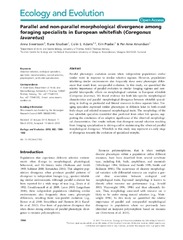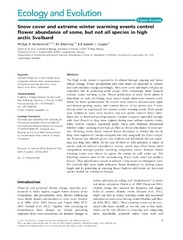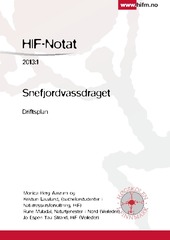Artikler, rapporter og annet (arktisk og marin biologi): Nye registreringer
Viser treff 1501-1520 av 1643
-
Parallel and non-parallel morphological divergence among foraging specialists in European whitefish (Coregonus lavaretus)
(Journal article; Tidsskriftartikkel; Peer reviewed, 2013)Parallel phenotypic evolution occurs when independent populations evolve similar traits in response to similar selective regimes. However, populations inhabiting similar environments also frequently show some phenotypic differences that result from non-parallel evolution. In this study, we quantified the relative importance of parallel evolution to similar foraging regimes and nonparallel lake-specific ... -
Cellulase activity screening using pure carboxymethylcellulose: Application to soluble cellulolytic samples and to plant tissue prints.
(Journal article; Tidsskriftartikkel; Peer reviewed, 2014)Reliable, rapid and inexpensive detection of cellulolytic enzymes that can be used for a wide variety of biological and environmental samples are currently in high demand. Here, a new cellulase detection protocol is described that circumvents problems observed with popular agar-based methods by exploiting the ability of carboxymethylcellulose (CMC) to form gel-like surfaces on its own. These pure ... -
Chemical Diversity as a Function of Temperature in Six Northern Diatom Species
(Journal article; Tidsskriftartikkel; Peer reviewed, 2013)In this study, we investigate how metabolic fingerprints are related to temperature. Six common northern temperate diatoms (Attheya longicornis, Chaetoceros socialis, Chaetoceros furcellatus, Porosira glacialis, Skeletonema marinoi, and Thalassiosira gravida) were cultivated at two different temperatures, 0.5 and 8.5 °C. To exclude metabolic variations due to differences in growth rates, the growth ... -
Snow cover and extreme winter warming events control flower abundance of some, but not all species in high arctic Svalbard
(Journal article; Tidsskriftartikkel; Peer reviewed, 2013)The High Arctic winter is expected to be altered through ongoing and future climate change. Winter precipitation and snow depth are projected to increase and melt out dates change accordingly. Also, snow cover and depth will play an important role in protecting plant canopy from increasingly more frequent extreme winter warming events. Flower production of many Arctic plants is dependent on melt ... -
Model of Tryptophan Metabolism, Readily Scalable Using Tissue-specific Gene Expression Data
(Journal article; Tidsskriftartikkel; Peer reviewed, 2013)Tryptophan is utilized in various metabolic routes including protein synthesis, serotonin, and melatonin synthesis and the kynurenine pathway. Perturbations in these pathways have been associated with neurodegenerative diseases and cancer. Here we present a comprehensive kinetic model of the complex network of human tryptophan metabolism based upon existing kinetic data for all enzymatic conversions ... -
Discrete foraging niches promote ecological, phenotypic, and genetic divergence in sympatric whitefish (Coregonus lavaretus)
(Journal article; Tidsskriftartikkel; Peer reviewed, 2012)Natural populations often vary in their degree of ecological, morphological and genetic divergence. This variation can be arranged along an ecological speciation continuum of increasingly discrete variation, with high inter-individual variation at one end and well defined species in the other. In postglacial fishes, evolutionary divergence has commonly resulted in the co-occurrence of a pelagic and ... -
A range-wide synthesis and timeline for phylogeographic events in the red fox (Vulpes vulpes)
(Journal article; Tidsskriftartikkel; Peer reviewed, 2013)Many boreo-temperate mammals have a Pleistocene fossil record throughout Eurasia and North America, but only few have a contemporary distribution that spans this large area. Examples of Holarctic-distributed carnivores are the brown bear, grey wolf, and red fox, all three ecological generalists with large dispersal capacity and a high adaptive flexibility. While the two former have been examined ... -
Ecological speciation in postglacial European whitefish: rapid adaptive radiations into the littoral, pelagic, and profundal lake habitats
(Journal article; Tidsskriftartikkel; Peer reviewed, 2013)Understanding how a monophyletic lineage of a species diverges into several adaptive forms has received increased attention in recent years, but the underlying mechanisms in this process are still under debate. Postglacial fishes are excellent model organisms for exploring this process, especially the initial stages of ecological speciation, as postglacial lakes represent replicated discrete ... -
What Do the IUCN Categories Really Protect? A Case Study of the Alpine Regions in Spain.
(Journal article; Tidsskriftartikkel; Peer reviewed, 2013)Protected area (PA) coverage is used as an indicator of biodiversity protection worldwide. The effectiveness of using PAs as indicators has been questioned due to the diversity of categories encompassed by such designations, especially in PAs established for purposes other than biodiversity protection. Although international standards have been developed by the International Union for Conservation ... -
The World's Northernmost Harbour Seal Population - How Many Are There?
(Journal article; Tidsskriftartikkel; Peer reviewed, 2013)This study presents the first abundance estimate for the world’s northernmost harbour seal (Phoca vitulina) population, which resides in Svalbard, Norway, based on three digital stereoscopic photographic surveys conducted in 2009 and 2010. The counts from these high resolution 3D images were combined with a novel method for estimating correction factors for animals that were in the water at the ... -
New production regulates export stoichiometry in the ocean
(Journal article; Tidsskriftartikkel; Peer reviewed, 2013)The proportion in which carbon and growth-limiting nutrients are exported from the oceans’ productive surface layer to the deep sea is a crucial parameter in models of the biological carbon pump. Based on .400 vertical flux observations of particulate organic carbon (POC) and nitrogen (PON) from the European Arctic Ocean we show the common assumption of constant C:N stoichiometry not to be met. ... -
Arctic Small Rodents Have Diverse Diets and Flexible Food Selection
(Journal article; Tidsskriftartikkel; Peer reviewed, 2013)The ecology of small rodent food selection is poorly understood, as mammalian herbivore food selection theory has mainly been developed by studying ungulates. Especially, the effect of food availability on food selection in natural habitats where a range of food items are available is unknown. We studied diets and selectivity of grey-sided voles (Myodes rufocanus) and tundra voles (Microtus oeconomus), ... -
Contrasting Population and Life History Responses of a Young Morph-Pair of European Whitefish to the Invasion of a Specialised Coregonid Competitor, Vendace
(Journal article; Tidsskriftartikkel; Peer reviewed, 2013)Invasions of non-native species represent a global problem of great scientific interest. Here we study in detail the response in population and life history characteristics of closely related native species, with divergent habitat preferences, that are impacted by an invading species over a sufficient time period to allow a new stable state to become established. A time series of 20 years starting ... -
Bacterial diversity of aMasi, a South African fermented milk product, determined by clone library and denaturing gradient gel electrophoresis analysis
(Journal article; Tidsskriftartikkel; Peer reviewed, 2013)In the present study, we investigated the bacterial diversity of aMasi, a traditional South African fermented milk product, by 16S rRNA clone library and Denaturing Gradient Gel Electrophoresis (DGGE) analysis. Two hundred and eighty two clones from clone library were isolated and identified from aMasi, prepared from the milk of four cows from one herd in the EkuPindiseni Community, North West of ... -
Homing behaviour of Atlantic salmon (Salmo salar) during final phase of marine migration and river entry
(Journal article; Tidsskriftartikkel; Peer reviewed, 2013)Little is known about Atlantic salmon behaviour during the last phase of the marine homing migration and subsequent river entry. In this study, 56 adult Atlantic salmon in the Alta Fjord in northern Norway were equipped with acoustic transmitters. Salmon generally followed the coastline, but their horizontal distribution was also affected by wind-induced spreading of river water across the fjord. ... -
Biovolume spectrum theories applied: spatial patterns of trophic levels within a mesozooplankton community at the polar front
(Journal article; Tidsskriftartikkel; Peer reviewed, 2010)Three-dimensional data on the mesoscale distribution of hydrography and mesozooplankton were collected at the Polar Front, northwestern Barents Sea, in spring 2008 (29 April 15 May) using a combination of multinet and towed instrument platform equipped with Laser Optical Plankton Counter, fluorometer and CTD. Trophic levels (TLS) within the zooplankton community (whole community and size-separated) ... -
Fjellrev i Finnmark” - Rapport for perioden 2008-2012.
(Research report; Forskningsrapport, 2013)Som et av to prosjekter i en stor nasjonal satsning for å redde den utrydningstruede fjellreven, ble «Fjellrev i Finnmark» startet opp våren 2004. Prosjektet har fra starten av hatt to hovedmålsettinger. 1)Å gjøre grunnleggende forskning på økosystembetingelser som begrenser fjellrevenbestandens nåværende utbredelse og bestandsvekst i Øst-Finnmark spesielt, og i sub- & lav-Arktis generelt, med ... -
How spatial variation in areal extent and configuration of labile vegetation states affect the riparian bird community in Arctic Tundra
(Journal article; Tidsskriftartikkel; Peer reviewed, 2013)The Arctic tundra is currently experiencing an unprecedented combination of climate change, change in grazing pressure by large herbivores and growing human activity. Thickets of tall shrubs represent a conspicuous vegetation state in northern and temperate ecosystems, where it serves important ecological functions, including habitat for wildlife. Thickets are however labile, as tall shrubs respond ... -
Arctic Ecosystem Services : interviews from Norway, Russia, Alaska and Canada
(Conference object; Konferansebidrag, 2013) -
Snefjordvassdraget. Driftsplan
(Research report; Forskningsrapport, 2013)


 English
English norsk
norsk


















